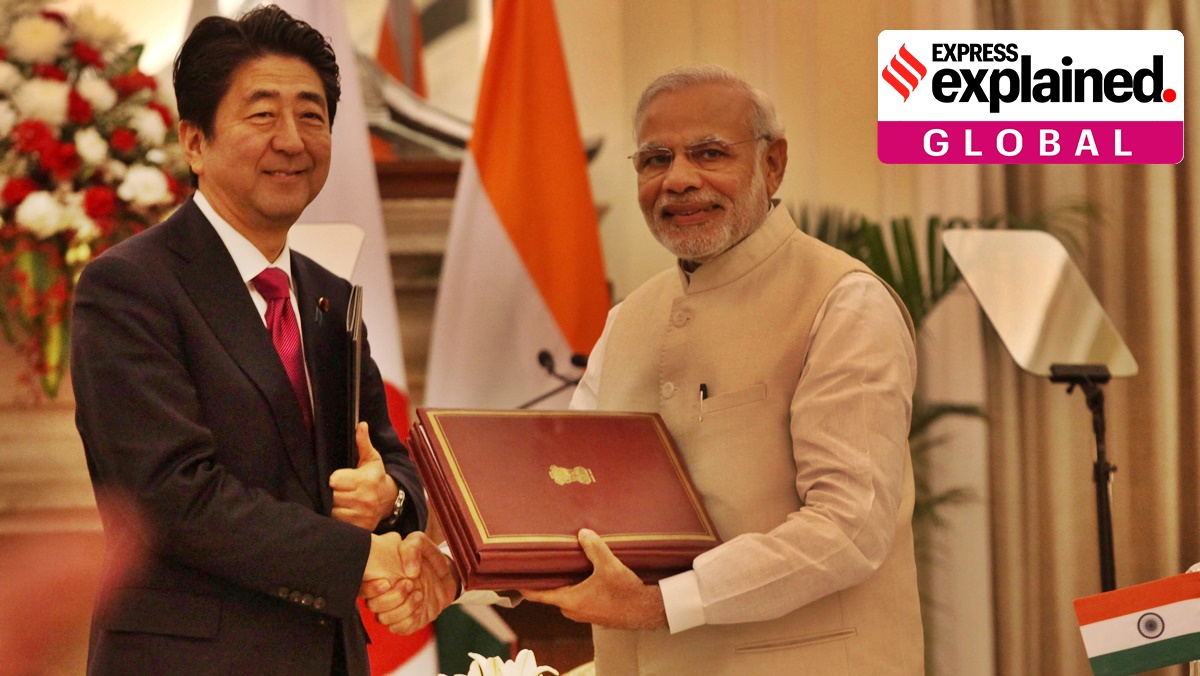
[ad_1]
 Shinzo Abe’s leadership has transformed Japan’s relationship with India. (Express photo: Renuka Puri)
Shinzo Abe’s leadership has transformed Japan’s relationship with India. (Express photo: Renuka Puri)
Japan’s Prime Minister Shinzo Abe announced on Friday that he would step down as a chronic illness has resurfaced. Abe, 65, was due to be in office till September 2021. He will stay on until his party chooses a successor, and will remain an MP.
Abe’s leadership has transformed Japan’s relationship with India.
Abe’s lineage
Abe comes from a political family. His grandfather Nobusuke Kishi was PM (1957-60), then his father Shintaro Abe was Foreign Minister (1982-86). On Monday, Abe became Japan’s longest-serving PM by consecutive days in office, overtaking the record of Eisaku Sato, his great-uncle, who served 2,798 days during 1964-72. Abe had first become the country’s PM in 2006, but resigned in 2007 due to illness. His current stint began in 2012.
Explained | Japan’s PM Shinzo Abe resigns: here’s how his tenure was and what happens next
Abe in India
In his first stint in 2006-07, Abe visited India and addressed Parliament. During his second stint, he visited India thrice (January 2014, December 2015, September 2017) — the most visits by any Japanese PM.
He was the first Japanese PM to be Chief Guest at the Republic Day parade in 2014. This reflected his commitment towards an India relationship — he was being hosted by a government that would be facing elections in May 2014. As Japan’s leader, he was wooed both by the UPA under Dr Manmohan Singh and the NDA under Narendra Modi.
Transformation in ties
While the foundation for “Global Partnership between Japan and India” was laid in 2001, and annual bilateral summits were agreed in 2005, Abe accelerated the pace of ties since 2012.
In August 2007, when Abe visited India for the first time as PM, he delivered the now-famous “Confluence of the Two Seas” speech — laying the foundation for his concept of Indo-Pacific. This concept has now become mainstream and one of the main pillars of India-Japan ties.
During his second term, Abe helped build the relationship further.
Having visited Japan several times as Gujarat CM, Modi as PM chose Japan for his first bilateral visit outside the neighbourhood, in September 2014. Modi and Abe agreed to upgrade the bilateral relationship to “Special Strategic and Global Partnership”. The relationship grew and encompassed issues from civilian nuclear energy to maritime security, bullet trains to quality infrastructure, Act East policy to Indo-Pacific strategy.
On Friday, after Abe announced his decision to step down, Modi tweeted: “Pained to hear about your ill health, my dear friend @AbeShinzo. In recent years, with your wise leadership and personal commitment, the India-Japan partnership has become deeper and stronger than ever before. I wish and pray for your speedy recovery.”
📣 Express Explained is now on Telegram. Click here to join our channel (@ieexplained) and stay updated with the latest
When Modi went to Japan in 2014, the Indo-Japan nuclear deal was still uncertain, with Tokyo sensitive about a pact with a non-Nuclear-Proliferation-Treaty member country. Abe’s government convinced the anti-nuclear hawks in Japan to sign the agreement in 2016. The pact was key to India’s deals with US and French nuclear firms, which were either owned by or had stakes in Japanese firms.
Defence and Indo-Pacific
While the security agreement was in place since 2008, under Abe the two sides decided to have Foreign and Defence Ministers’ Meeting (2+2), and are negotiating the Acquisition and Cross-Servicing Agreement — a kind of military logistics support pact. In November 2019, the first Foreign and Defence Ministers’ Meeting was held in New Delhi. A pact for transfer of defence equipment and technology was also signed in 2015, an uncommon agreement for post-War Japan.
During Abe’s tenure, India and Japan came closer in the Indo-Pacific architecture. Abe had spelt out his vision of the Confluence of the Two Seas in his 2007 speech when the Quad was formed. It collapsed soon, but in October 2017, as Chinese aggression grew in the Pacific, Indian Ocean, and India’s borders in Doklam, it was Abe’s Japan that really mooted the idea of reviving the Quad. In November 2017, it was revived as Indian, Japanese, Australia and US officials met in Manila on the sidelines of the East Asia summit.
India-China stand-offs
Since 2013, Indian and Chinese soldiers have had four publicly known border-stand-offs — April 2013, September 2014, June-August 2017, and the ongoing one since May 2020. Abe’s Japan has stood with India through each of them. During the Doklam crisis and the current stand-off, Japan has made statements against China for changing the status quo.
Infrastructure
During Abe’s visit in 2015, India decided to introduce the Shinkansen system (bullet train), due to begin in 2022. Under Abe’s leadership, India and Japan also formed the Act East Forum and are engaged in projects in the Northeast, closely watched by China. The two countries also planned joint projects in Maldives and Sri Lanka among others to counter Beijing’s influence.
lso read | Who takes over now that Japan’s Prime Minister Shinzo Abe has resigned?
What next
Abe has been a valuable G-7 leader for India, focused on strategic, economic and political deliverables, and not getting distracted by India’s domestic developments — much to New Delhi’s comfort.
Having hosted Modi at his ancestral home in Yamanashi, the first such reception extended to a foreign leader, Abe was feted at a roadshow in Ahmedabad. His planned visit to India last December in Guwahati, however, was cancelled due to the protests against the Citizenship Amendment Act.
New Delhi will now wait for Abe’s successor — who, as a South Block official said, “will have big shoes to fill”.
📣 The Indian Express is now on Telegram. Click here to join our channel (@indianexpress) and stay updated with the latest headlines
For all the latest Explained News, download Indian Express App.
© The Indian Express (P) Ltd
[ad_2]
Source link